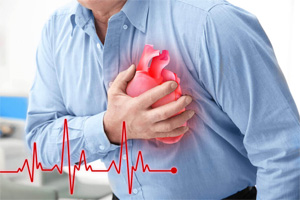- Home
- Editorial
- News
- Practice Guidelines
- Anesthesiology Guidelines
- Cancer Guidelines
- Cardiac Sciences Guidelines
- Critical Care Guidelines
- Dentistry Guidelines
- Dermatology Guidelines
- Diabetes and Endo Guidelines
- Diagnostics Guidelines
- ENT Guidelines
- Featured Practice Guidelines
- Gastroenterology Guidelines
- Geriatrics Guidelines
- Medicine Guidelines
- Nephrology Guidelines
- Neurosciences Guidelines
- Obs and Gynae Guidelines
- Ophthalmology Guidelines
- Orthopaedics Guidelines
- Paediatrics Guidelines
- Psychiatry Guidelines
- Pulmonology Guidelines
- Radiology Guidelines
- Surgery Guidelines
- Urology Guidelines
New Definition of Heart attack in International Guidelines : ESC

The new guidelines have been issued by the leading major world cardiology associations to update and standardize "what is a heart attack". Confusion over how to diagnose a heart attack is set to be cleared up with new guidance launched.
“Unless there is clarity in the emergency room on what defines a heart attack, patients with chest pain may be wrongly labeled with the heart attack and not receive the correct treatment,” said Professor Kristian Thygesen, Aarhus University Hospital, Denmark.
The 2018 Fourth Universal Definition of Myocardial Infarction has been published in European Heart Journal which added the concept of "Myocardial injury" defined as a rise in troponin without other symptoms or components of myocardial infarction.
The updated guidelines are the 4-year work of a committee representing cardiologists and other healthcare professionals from the European Society of Cardiology, the American College of Cardiology, the American Heart Association, and the World Heart Federation.
“Many doctors have not understood that elevated troponin levels in the blood are not sufficient to diagnose a heart attack and this has created real problems,” said Thygesen, who was joint chair of the Task Force that wrote the document.
A cardiac injury is defined as a rise in troponin without other symptoms or components of myocardial infarction.
The term acute myocardial infarction should be used when there is an acute myocardial injury with clinical evidence of acute myocardial ischemia and with detection of a rise and/or fall of cardiac troponin values with at least one value above the 99th percentile upper reference limit and at least one of the following:
- Symptoms of myocardial ischemia
- New ischemic electrocardiogram (ECG) changes
- Development of pathological Q waves
- Imaging evidence of new loss of viable myocardium or new regional wall motion abnormality in a pattern consistent with an ischemic etiology
- Identification of a coronary thrombus by angiography or autopsy
The international consensus document states out that a heart attack (myocardial infarction) has occurred when the heart muscle (myocardium) is injured and has insufficient oxygen. Troponin is a protein normally used by the heart muscle for contraction but is released into the blood when the muscle is injured. Oxygen shortage (ischemia) is detected by electrocardiogram (ECG) and symptoms such as pain in the chest, arms, or jaw, shortness of breath, and tiredness.
Myocardial injury on its own is now considered a separate condition. There are numerous situations which can cause myocardial injury, and therefore a rise in troponin. These include infection, sepsis, kidney disease, heart surgery, and strenuous exercise. The first step of treatment is to address the underlying disorder.
As for myocardial infarction, there are different types which require specific treatment. Type 1 is the situation which most people associate with a heart attack. Here a fatty deposit in an artery called a plaque, ruptures and blocks blood flow to the heart which deprives it of oxygen. Treatment can include antiplatelet medication to stop platelets from clumping together and forming a clot, inserting a stent via a catheter to open up the artery, or surgery to bypass the artery.
In type 2, oxygen deprivation is not caused by plaque rupture in an artery but is due to other reasons such as respiratory failure or severe hypertension. Professor Alpert said: “Some doctors have incorrectly called this type 1 and given the wrong treatment, which can be harmful. Treatment should be directed at the underlying condition, for example, blood pressure lowering medications for patients with hypertension.”

Disclaimer: This site is primarily intended for healthcare professionals. Any content/information on this website does not replace the advice of medical and/or health professionals and should not be construed as medical/diagnostic advice/endorsement or prescription. Use of this site is subject to our terms of use, privacy policy, advertisement policy. © 2020 Minerva Medical Treatment Pvt Ltd